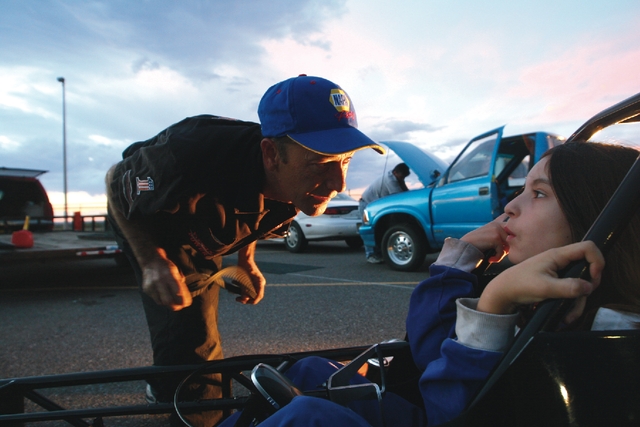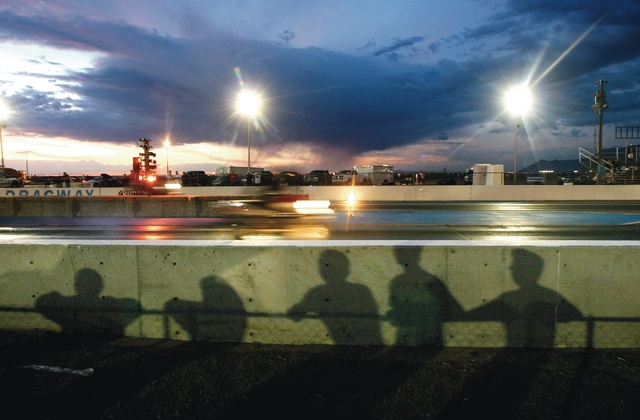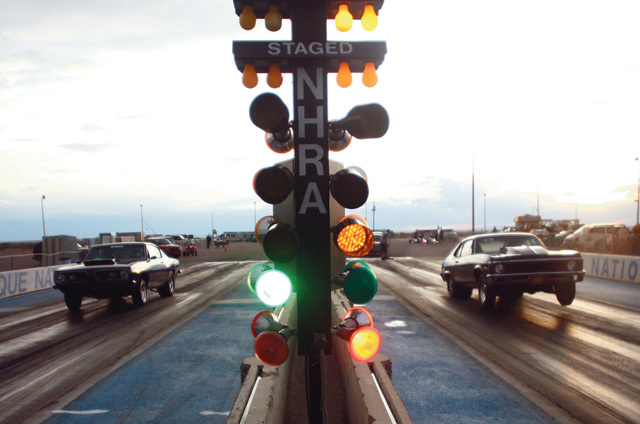The grandstanding starts on Bobby Foster Road, a barely visible side street that’s easy to miss. Flashy cars with overlarge spoilers and air-intakes on the hoods exit the industrial sector of South Broadway and climb into the dunes. Bobby Foster leads to another long desert road that stretches into sandy nothing. Wind kicks up plenty of dirt, and the sporty vehicles become only taillights. One more turnoff marked by a badly faded sign with the National Hot Rod Association’s logo, and then we’re climbing up the hill. The Albuquerque Dragway still isn’t in sight. "People who have lived here all their lives are unaware that it’s there, and that it’s utilized every weekend," says Bill Elliot, who co-owns Albuquerque’s drag strip. The dragway’s the only one of its kind within 300 or 400 miles. Turning a corner, the stadium lights are visible first. Standing sentry at the entryway are a few tollbooths. The lines are short but slow-moving. Engines thunder in the distance. Driving through the lines of racers, real beauties emerge—a late ’70s Camaro, a Mustang, a Cobalt SS, two Hyundai Tiburons, a quirky little Sunbeam Tiger. Trailers promise vehicles on racing slicks (tires without the tread that therefore have maximum surface grip). Slicks aren’t street legal. Written on some cars in white shoe polish is “NOS,” Nitrous Oxide Systems. Two cars sport parachutes, required for any vehicle that will do over 150 mph in the quarter mile. Dual chutes are mandatory for vehicles that top 200 mph. "These guys work regular jobs like you and me, but on the weekends, it’s time to go racing," the announcer tells the crowd. "And they’re really serious." It’s Fourth of July weekend, and the dragway’s putting on the Ritz. Cars from all over the county creep up the line into the staging area. The traffic light, called a tree, blinks yellows 0.5 seconds apart. Finally, it drops to green and the race begins. Off the Streets Dragway co-owner Elliot had a midlife crisis about 10 years ago. He bought a ’67 Camaro pro street car, which is a street-legal race car. "I was scared of running that car on the street, so I ended up taking that car to the drag strip." He fell in love with drag racing and the dragway. "You don’t have to worry about getting tickets. You don’t have issues with people getting hurt on the street." At the end of May, the Albuquerque Police Department announced a series of special operations targeting traffic violations. Among them: drag racing, loud music and excessive engine noise. "A lot of kids are out racing on the street, and that’s the wrong way to do it," Elliot says. Because of a land dispute, the strip was closed between 2000 and 2002, and Elliot says the city saw an increase in street racing. "I worked closely with the land commissioner, Pat Lyons, and he graciously re-opened our track as soon as we assisted in getting him elected," he says. Scars of that battle are in evidence at the track in the form of one or two scratched, faded Lyons bumper stickers on the tech shack. Elliot estimates the strip pulls between 75 and 125 cars off Albuquerque’s streets every Friday and Saturday night. The 961-Pound Jet Car The grandstands are packed with spectators. More watch from lawn chairs in the beds of their pickups. A few diehards rest their arms on the 5-foot-tall fence right next to the starting line. One man nods his head to the pulsing of an engine like he’s hearing his favorite song. The Junior Dragsters roll out, and they are what they sound like—kids in small drag cars hauling butt down the track. The funny cars are out tonight. This is a car where the entire body, not just the hood, can be lifted to reveal the forward-mounted engine. The announcer is sure to mention that the body alone on a funny car goes for somewhere between $6,000 and $10,000. Racers compete in a burnout contest this evening. Usually, racers do burnouts before getting into position to rub any road dirt off the tires. Burnouts heat the tires, rendering them stickier. They also make for a good show, and plumes of stinky white-blue smoke rise into the air and over the audience.The show stealers, though, are the super jet funny cars. Literally cars with jet engines under the hood, the sound they make is exactly the same as a passenger jet taking off. A jet engine weighs only 214 pounds, says the announcer, and is about 3 feet in length. The Super Cobra Jet we’re looking at weighs only 961 pounds total. The high-pitched whine is punctuated by short spurts that propel the car forward in jumps. Huge flames shoot out the back with each booming burst. When the jet cars explode off the starting line, those flames turn long and blue. Asphalt Costs Money Though the dragway puts together a great show and has a loyal following, the track is still fighting to survive. "Albuquerque Dragway is being developed out of its current space," says co-owner Robert Costa. "We should be open for approximately three years before having to relocate." Costa, Elliot and Mike Labate purchased the track this year. What prompted Costa to buy it up? "Stupidity?" Costa laughs. "No, it’s the love of the sport and wanting to make sure drag racing in the Albuquerque area continues for years to come.”Costa races. So does his wife, his brother, and, once upon a time, his son and niece, too. Costa runs a traditional dragster, a one-seater with a long, pointed nose and cage for the driver. He’s also got a 1955 Chevy.The Albuquerque Dragway is on a short-term lease with the New Mexico State Land Office. Mesa del Sol, a housing and business development, will take over the land in about three years and will have a long-term lease. So Albuquerque Dragway is moving, probably out somewhere by Double Eagle Airport on the Westside. The owners will have to rebuild the track—and it won’t be cheap. "We’re looking at an absolute minimum of several million dollars to build a new track, and that’s just to replace what we have," Costa says. "That’s not even upgrading to a bigger, nicer facility." The primary expense is asphalt, and the owners are concerned about the rising cost of gasoline. The Matching Helmet A first-time racer we’ll call Jack fills up on 101 octane fuel before we get to the strip. It costs about $7 per gallon. This is not a big night like the Fourth of July, just a standard evening of grudge matches and bracket races. We pay the $15 racing fee and drive up to the tech shack where a technician looks under the hood of Jack’s car. The technician gives me a helmet, required for all passengers. He’s careful to choose a color that matches the vehicle. He draws “23” on the window in shoe polish and sends us around the corner to wait with the other racers. Two by two, they pull up to the staging area. A PT Cruiser takes on a modern Volkswagen Beetle. Then we’re up. Jack tells me before the race he’s worried about ruining his transmission by forcing it into inappropriate gears while hopped up on the adrenaline of racing. There’s a moment of intense concentration as the tree flashes its three yellow lights. Then, green, and we’re off. Though Jack’s accelerating as fast as he can down the quarter mile, it’s exhilarating, but not frightening. A single, uninterrupted lane stretches before us, and there’s very little danger. Conquering the Machine Of course, we were not in a car with 3,300 horsepower, like the one Lawren Jones is building. Jones builds race cars in Albuquerque. He’s working on a pro mod, a car with a really big engine. "It’s a very highly modified car that’s capable of doing 0 to 240 in less than six seconds," Jones explains. All the parts will be custom fabricated. When it’s done, he says, it will be worth anywhere from $150,000 to $175,000. To start working on the pro mod, he sold his funny car, with which he snagged the track record at Albuquerque Dragway at 6:24 seconds with a final speed of 232 mph. (For comparison, Jack and I went down the quarter mile in about 17 seconds with a top speed of 82 mph). Jones started racing at the dragstrip when he was 15 years old. That was 40 years ago. He owns Law-ru Motorsports and is a race car mechanic, custom parts fabricator and consultant. "People wanted me to work on their stuff, and I was getting more work than I could not report to the IRS," he says.Jones used to race the cars himself, but now his son, Shawn, drives. Physically, Lawren Jones says, the most challenging aspect of racing is the g -force. "When these things leave the starting line, they leave the starting line at about four g’s ." The exciting part, he says, is in the simple task of keeping the car straight. "Keeping that kind of horsepower controlled and keeping it on two slicks that are 17 inches wide is very hard to do. The satisfaction is to be able to conquer and beat the racetrack and the machine and keep everything still in tact without hitting a wall or blowing the engine up."Jones has crashed two cars, and his son crashed one. And when you wreck a car like this, it’s very difficult to get back into another, not just financially. After a particularly frightening crash, Jones was also struggling emotionally with racing, he says. "I wasn’t sure if I wanted to do it again." The rush and the love is hard for Jones to explain. "Do you like a big chocolate éclair and how it tastes when you haven’t had one? Well, that’s how these things are. It’s the most satisfying thing to conquer them and to drive them. That’s how come you get hooked on them. They’re a disease." Streetcar Racers After racing his midlife-crisis mobile, Elliot traded it for a "real race car," he says. In his ’57 Corvette, a super gas car built by Don Davis of El Paso, is a computer that can slow or speed his reaction time depending on how he’s feeling that day. "Some days you’re a little bit more wound-up and you would be too quick to react to a light," he says. "So you can add time into the timer to slow you down, and you can move that timer back and forth." Many races are won and lost depending on the reaction time of the driver to the green light. The first time Elliot raced, he remembers being intimidated. "Once I did it three or four times, I realized, You know, this isn’t a big deal." Albuquerque Dragway hosts mostly bracket racing, a process by which a racer dials in a car as fast as it can go and then tries to get as close to that time as possible without going any faster. And the beautiful thing about bracket racing, says Elliot, is that anyone can do it with any car. "If you went out there and you’re running a Pontiac station wagon and somebody else is running a GTO, which might be faster than your car, what happens is you get an advantage, you get to leave first," he says. Elliot says he knows a guy who races each weekend using his everyday street car. Elliot’s crew chief helps him with his sophisticated car but also takes his street car with 140,000 miles on it to the track. "He is currently No. 1 in points at the drag strip in his division, and I’m nowhere near that. And he drives his car back and forth to the track, runs regular fuel and has every bit as much fun as I do."Drag racing is educational, Elliot says. There’s math, geometry and engineering involved. "You’ve got to be a pretty talented human being to come out here and figure out how to make your car go faster," he says. "The sport keeps growing and growing nationally. If we lose our venue … ”
For the racing schedule, directions and hours, go to abqdragway.com.













